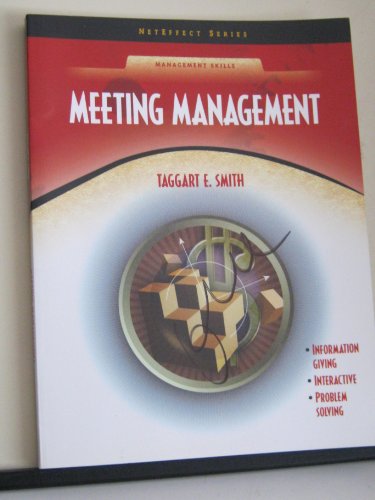Meeting Management - Softcover

This book provides practical information on a major business concern—how to manage meetings. It demonstrates how to lead them effectively, in the shortest time frame possible. Three types of meetings are outlined: information-giving, interactive, and problem solving, with details on how to prepare for and preside over each. Chapter topics include an overview of the meeting process; structuring a topic and organizing the message; audience; platform conduct; visuals; agendas; disruptions; and asking and answering questions. For training programs in business and industry. y.
"synopsis" may belong to another edition of this title.
Behavioral scientists have been studying how to make meetings more effective for decades. This book is not necessarily a breakthrough in this study, but it does offer an applied framework for managing meetings, rather than a theoretical one. One thing is certain: Quality of leadership is an important determinant of meeting success.
Conducting a meeting is a difficult job, because groups want leaders with just the right balance between "taking charge" and "letting go." Leaders who are too dominant or too passive will have ineffective group meetings. An effective leader balances process control and content control, which requires considerable skill., Meetings function as information-processing systems in organizations. In good meetings, issues are fully discussed, decisions are well considered and need no rework, and participants feel good about participating. A meeting leader, then, is responsible for the contribution of information and ideas by group members, the clarity of communication, the focus of discussion, and the resolution of disagreement. There are ways to plan and conduct meetings that accomplish these purposes, and that is where this book comes in.
Chapters 1, 2, and 3 show how to organize and present information-giving meetings. Everything from outlining key points, maintaining interest, using visuals, and employing nonverbal communication is addressed. Chapters 4, 5, and 6 prepare leaders for interactive meetings. Here leaders learn when to have meetings, why they are necessary, what roles are recommended, and how to deal with classic problems of meeting disruptions. Chapter 7 examines problem-solving meetings in depth and features some examples and a practice exercise. Chapter 8 offers details on conducting discussions with special emphasis on asking questions and gaining consensus in groups. A method of determining the best solutions to problems is described using construction of criteria for judging different alternatives.
For each of these three meetings, content outlines are provided, along with critique sheets and observation sheets. Again, the emphasis here is application oriented. These outlines provide ways to process information in organizations, to solve problems using group input, and to decide the best way to proceed when solutions are found. During the learning process, leaders find their strengths and weaknesses and practice getting groups to respond efficiently and effectively.
The material for this book evolved from a business administration curriculum at Purdue University. The book emerged over time and in response to the expressed needs of students as they honed their meeting management skills. Thus, the "best and the brightest," in this author's opinion, created this book.
In summary, the study of managing meetings has been going on for some time—and continues still. This book attempts to put a practical face on the problem of leading meetings effectively and efficiently. Just as we never outgrow our need for milk, at least according to current advertising, we never outgrow our need for efficient meetings. Even in this age of continuous innovation in communication, we still need face-to-face meetings to make quality decisions.
Jeff Bezos, Amazon's chief, in an interview for the Wall Street Journal, had this to say:
WSJ: How do you work with your directors? Something tells me this isn't quite like U. S. Steel in the 1920s, with a long mahogany table and six-hour board meetings.
BEZOS: We're actually a little old-fashioned in this respect. There's nothing better than an in-person meeting. Nothing yet has replicated that, as far as I know. For quick interaction, e-mail and phone are great. But for really getting into something, a physical meeting is much better. We laugh a lot at our board meetings-and we get a lot done. (Wall Street Journal, February 4, 2000, pp. B1-B4.)
If Mr. Dot Com himself considers meetings important, so should we. Acknowledgments
We would like to thank these experts for their valuable advice:
Virginia Dumont-Poston, Lander University Katherine H. Isenburg, Indian River Community College Estelle Kochis, Suffolk Community College Jo Ann Mitchell, University of Southern Mississippi
"About this title" may belong to another edition of this title.
- PublisherPrentice Hall
- Publication date2000
- ISBN 10 0130173916
- ISBN 13 9780130173911
- BindingPaperback
- Edition number1
- Number of pages166
Buy New
Learn more about this copy
Shipping:
US$ 4.25
Within U.S.A.
Top Search Results from the AbeBooks Marketplace
Meeting Management
Book Description Paperback. Condition: new. New Copy. Customer Service Guaranteed. Seller Inventory # think0130173916

